Basements can feel gloomy and uninviting, but the right lighting can completely transform them. Choosing the best recessed ceiling lights for basement means balancing brightness, energy efficiency, and style, even when you’re dealing with unfinished ceilings or tight joist spaces. Let’s explore the best options, practical setup ideas, and professional tips to make your basement glow like a finished living area.
Why Lighting Matters in a Basement
Basements often have low ceilings, concrete walls, and minimal daylight. That’s why lighting design should focus on brightness, coverage, and color temperature. If you’re planning an upgrade, consider:
✅ Higher lumen output: Aim for 900–1200 lumens per fixture.
✅ Neutral white tones (3000K–4000K): Mimic daylight without feeling harsh.
✅ Dimmable options: For flexible mood control.
✅ Damp-rated fixtures: Especially useful if moisture is an issue.
✅ Shallow or canless designs: Ideal for low or exposed ceilings.
You can also enhance your look by painting ceiling beams white, check our guide on best paint for unfinished basement ceiling for tips.
1. Amico 6-Inch 5CCT Ultra-Thin LED Recessed Ceiling Light
Description
The Amico 6-inch Ultra-Thin LED Recessed Light is one of the most popular canless lighting options. It’s perfect for tight spaces like unfinished basements or joist ceilings where traditional cans won’t fit. With a built-in junction box and only 0.4 inches of thickness, it installs easily with spring clips. It also offers five color temperatures (2700K–5000K), giving you control from warm white to daylight. Producing 1050 lumens at 12 watts, it’s powerful yet energy-efficient.
Pros ✅
- Ultra-thin design ideal for limited clearance
- Five selectable color temperatures
- Damp-rated for basements and bathrooms
- Smooth dimming from 5%–100%
- ETL and Energy Star certified
Cons ❌
- Color selector switch can be hard to access once installed
- Some users report flickering with incompatible dimmers
Verdict
If you’re looking for the best lighting for unfinished basement, Amico’s versatility, thin profile, and color options make it a top pick.
2. Ensenior 6-Inch 5CCT Ultra-Thin LED Recessed Light
Description
The Ensenior Ultra-Thin LED Recessed Light competes closely with Amico. It provides 1050 lumens, adjustable color temperatures (2700K–5000K), and a slim 0.4-inch profile. The installation is tool-free with a simple junction box connection, making it ideal for DIYers upgrading their unfinished basement ceiling lighting ideas. This light is Energy Star certified, has a 5-year warranty, and a lifespan of up to 50,000 hours.
Pros ✅
- Consistent brightness with no flicker
- 5CCT color range flexibility
- Energy-efficient (12 W)
- Suitable for damp areas and low ceilings
- Long lifespan and UL-certified
Cons ❌
- Spring clips may feel tight for some ceiling thicknesses
- Junction box design could be more compact
Verdict
For homeowners seeking brightest lights for basement ceiling, Ensenior’s 1050-lumen output ensures ample coverage with a smooth, modern look.
3. Halo HLB4069FS1EMWR 4-Inch Canless LED Downlight
Description
The Halo HLB4 series is an electrician-favorite for its build quality and light consistency. This model features five selectable color temperatures (2700K–5000K), and the deep-recessed baffle reduces glare — perfect for areas like TV corners or entertainment setups in the basement. The light is wet-location rated, meaning it can handle damp environments without corrosion or shorting.
Pros ✅
- Excellent light diffusion and color accuracy
- High CRI (90+) for realistic color tone
- Wet-rated for humid basements
- Compatible with most dimmers
- Trusted professional brand
Cons ❌
- Slightly higher price than generic brands
- Requires careful handling of clips during install
Verdict
If you value premium quality and recessed lighting for unfinished basement that feels professional-grade, Halo is the best choice.
4. Lithonia Lighting WF6 LED 30K40K50K
Description
The Lithonia WF6 wafer LED delivers bright, uniform light with selectable color temperatures (3000K/4000K/5000K). The housing-free installation and ultra-slim design make it excellent for unfinished basement light fixtures ceiling installations with tight joist spacing. It’s damp-rated and features a polycarbonate lens for durability against moisture and dust, ideal for basements with utility equipment.
Pros ✅
- Solid aluminum build with excellent heat dissipation
- Crisp light distribution with no hotspots
- Long lifespan (50,000+ hours)
- Reliable brand used by contractors
Cons ❌
- Slightly cooler tone even at 3000K
- Non-swivel trim (not adjustable)
Verdict
A professional-grade pick for bright, uniform basement coverage, perfect for both finished and unfinished ceilings.
5. Torchstar Basic Series 6-Inch Recessed LED Downlight
Description
If you’re on a budget, the Torchstar Basic Series is the best affordable recessed lighting set. It offers 1000 lumens per fixture, 90+ CRI, and easy installation with no housing required. The dimmable feature works with most LED dimmers. This light is damp-rated and certified for energy efficiency, making it a great value option for large basements.
Pros ✅
- Budget-friendly without quality compromise
- High CRI for better color rendering
- 1000 lumens brightness
- Dimmable and flicker-free performance
Cons ❌
- Limited color temperature range (3000K only)
- Slightly bulkier trim
Verdict
Torchstar is an excellent starter choice for homeowners looking for best lights for unfinished basement without spending much.
Layout Tips: How Many Lights & Where to Place Them
- Spacing rule of thumb: A rough guideline is half the height of the ceiling (in feet) for spacing between lights. So a 7 ft ceiling → space about 3.5–4 ft apart.
- Peripheral lighting + fill: Place lights along walls first (walls typically “steal” more light), then fill in the center.
- Zoning & layers: Consider grouping lights into zones (e.g. seating area, play area, utility section) and wire them on separate circuits or switches.
- Supplement with other lighting: Even in a design focused on recessed, you can mix in exposed basement ceiling string lights or track fixtures in portions where you want ambiance or accent light.
Using unfinished basement light fixtures ceiling such as surface-mounted LED strips or channel lights in utility zones can complement the ambient glow from recessed.
Creative Exposed Basement Ceiling Lighting Ideas
When your ceiling is open, joists, pipes, wires, you have freedom (and constraints). Here are ideas to balance form and function:
- Frame-mounted rails with spotlight heads: Attach a small rail underneath the joists and snap on directional LED heads. This gives flexibility to move the “spotlight.”
- String lights along beams: Use rugged, bulb-style string lights (Edison or LED) clipped or draped along the beams for low-level ambient light. This can soften shadows between recessed zones and supply that cozy “under-deck” vibe.
- Wall wash via adjustable trims: Use gimbal or eyeball trims oriented toward walls to brighten vertical surfaces and avoid dark corners.
- Paint the underside of joists white or light tones: Light-colored surfaces bounce more light. (You might pair this with advice from best paint for unfinished basement ceiling topics in painting blogs.)
- Hybrid approach: Use the recessed as the “daylight” base level, and bring in accent fixtures or uplights behind pillars, beneath stairs, or near displays.
How to Choose the Brightest Lights for Basement Ceiling
If your goal is maximum brightness (within reason), here’s how to shop smart:
- Lumens per watt (efficacy): a modern LED should give you 80–110+ lm/W.
- High lumen output: don’t settle for low-output fixtures in big rooms.
- Efficient beam distribution + well-placed spacing: a powerful lamp poorly aimed or sparsely installed won’t deliver uniform brightness.
- Avoid overdoing color temperature extremes: ultra-cool 5000 K might look harsh; mixing in 3000–3500 K in certain zones helps visual balance.
- Multiple circuits and dimming options: gives you flexibility to crank brightness up when needed, lower it when relaxing.
Thus, when someone searches for “brightest lights for basement ceiling,” they should look for high-lumen, high-efficiency, wide-angle or adjustable fixtures, spaced appropriately.
Comparing Scenarios: Finished vs. Unfinished Basements
If you’re working in a finished ceiling (drywall, drop ceiling), the usual can + retrofit trims work fine. But for the best lighting for unfinished basement, your constraints shift: you’ll favor shallow-profile fixtures or direct-mount modules that avoid depth conflicts.
When ceilings are finished, you might also paint edges, choose decorative trim, and hide wiring. For an unfinished ceiling, your choices must lean toward versatility, serviceability and practicality.
By combining smart lighting design with good finishing (for instance, painting the beams or ceiling areas between joists), you can nearly erase the “unfinished feel,” while using best lights for unfinished basement schemes.
Pros, Cons & Tips from Real Users: What You Need to Know
- Color consistency across batches: Some users report slight shifts in color temperature when replacing fixtures from different production runs. Stick to the same batch or brand when possible.
- Dimming behavior: Many cheaper LED modules flicker or don’t dim smoothly on older dimmer circuits. Test early.
- Glare & eyeball fatigue: Deep-well trims (or narrow-beam inserts) help reduce glare in spaces where you might sometimes look up.
- Serviceability: In basements, you may later need access for wiring, plumbing, or HVAC. Fixtures that snap in/out or modules that can be replaced are safer bets.
- Humidity concerns: If your basement sees dampness, go for fixtures rated for damp locations and seal junctions well.
Final Verdict
If you want professional brightness and flexibility:
Amico 6-Inch Ultra-Thin LED: Best overall for versatility and installation ease.
For budget-conscious homeowners:
Torchstar Basic Series : Great quality at a lower price.
For premium build and lighting quality:
Halo HLB4: Exceptional color accuracy and durability.
Choose based on your ceiling type (finished vs. unfinished) and the level of brightness you want. And if you’re refreshing the entire space, explore best paint for concrete ceiling or best black paint for exposed basement ceiling to complete the transformation.

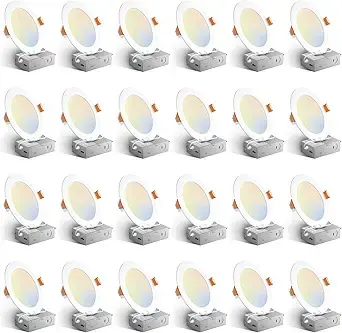
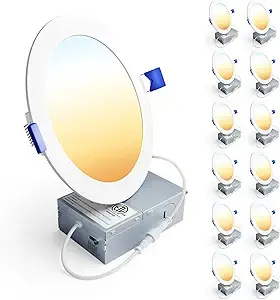
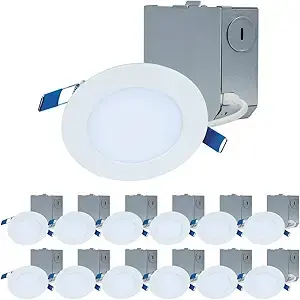
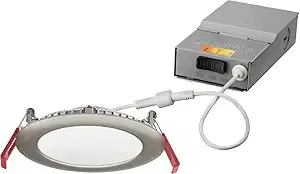
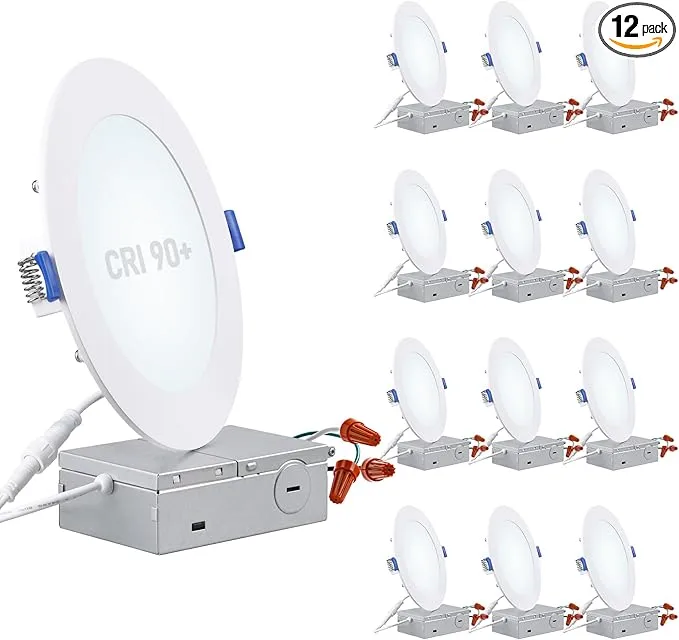
Leave a Reply